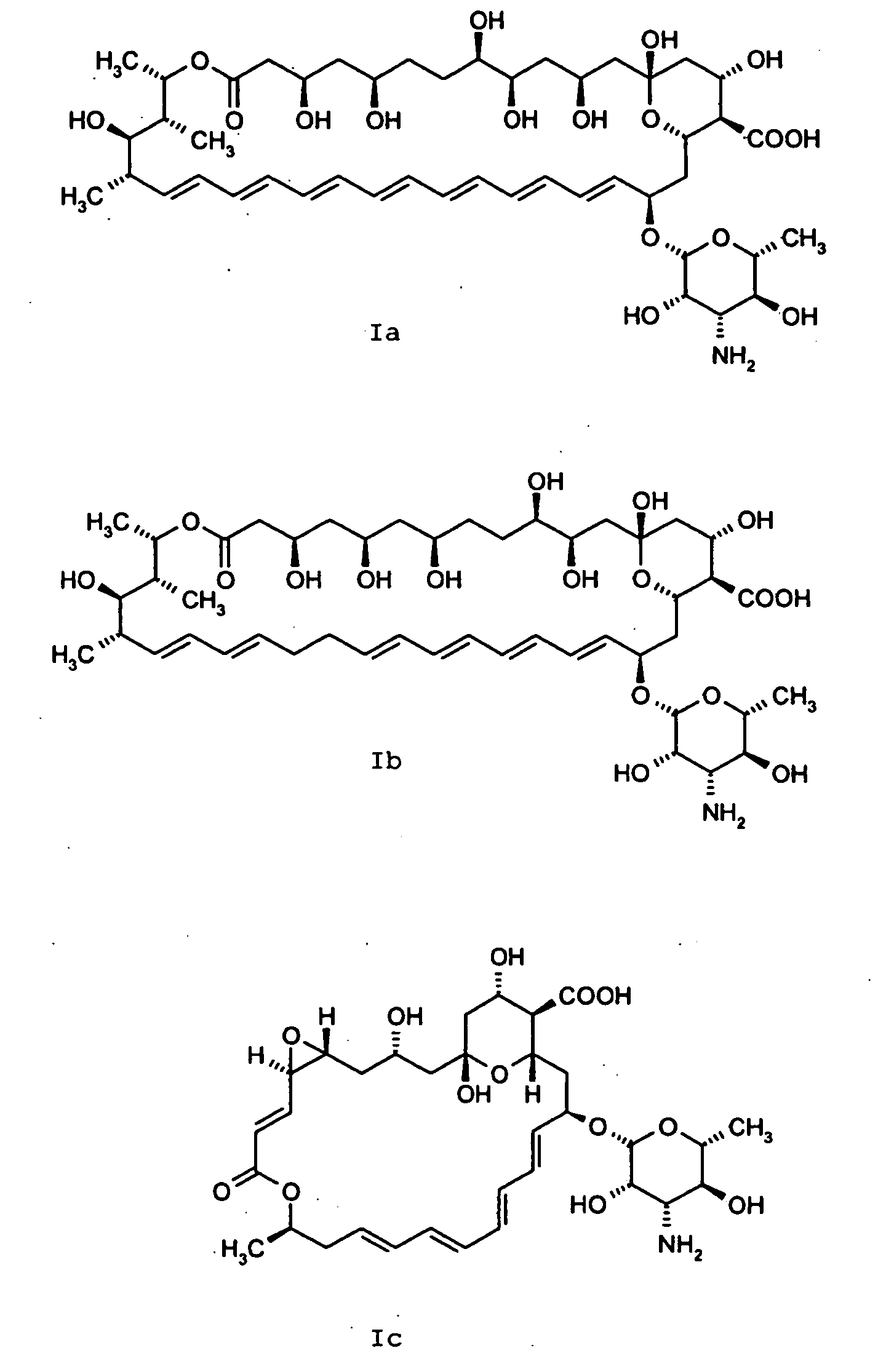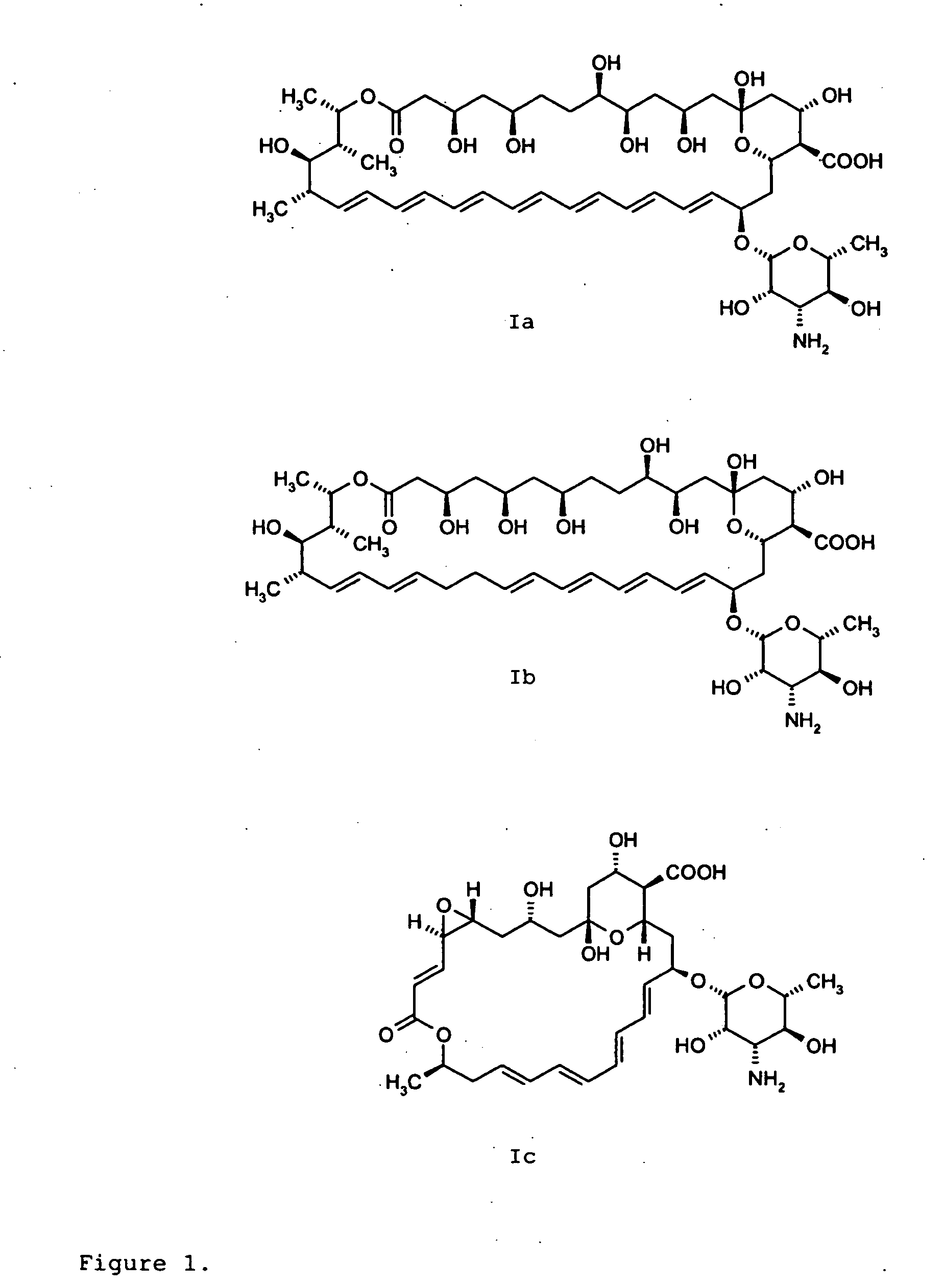Amphotericin Derivatives
a technology of amphotericin and derivatives, which is applied in the field of new polyene macrolide derivatives, can solve the problems of increasing the permeability of the membrane, affecting the bacterial infection rate, and affecting the survival rate of the organism, so as to achieve the effect of reducing hemotoxicity and high water solubility
- Summary
- Abstract
- Description
- Claims
- Application Information
AI Technical Summary
Benefits of technology
Problems solved by technology
Method used
Image
Examples
example 1
Synthesis of N,N-Di-(2-aminoethyl)-AmB (2)
[0242]
[0243]To a solution of N-(9-fluorenylmethoxycarbonyl)-2-aminoacetaldehyde (290 mg, 1.03 mmol) and AmB (1a) (320 mg, 0.340 mmol) in DMF (3.00 mL) was added NaBH3CN (65.0 mg, 1.03 mmol) followed by a drop of conc. HCl. After 16 h at room temperature, Amberlite IRA-743 (500 mg) was added and the mixture was stirred for an hour. After filtration, the solution was concentrated down and added dropwise to diethyl ether (250 mL). The yellow precipitate was filtered and purified by flash chromatography (40-8-1 CHCl3-MeOH—H2O). The isolated yellow solid was dissolved in DMSO (5.00 mL) and piperidine (0.200 mL, 2.10 mmol) was added. After 2 h at room temperature, the solution was added dropwise to diethyl ether (250 mL). The yellow precipitate was filtered and washed with diethyl ether (2×100 mL) providing the desired compound 2 as a yellow solid (70 mg, 74%). 1H NMR (500 MHz, DMSO-d6) δ 6.46-6.01 (m, 13H), 5.42 (dd, J=15, 10 Hz, 1H), 5.23 (s (br...
example 2
Synthesis of N,N-Di-(3-aminopropyl)-AmB (3)
[0246]
[0247]To a solution of N,N-di-{N-(9-fluorenylmethoxycarbonyl)-3-aminopropyl}-AmB (200 mg, 0.135 mmol) in DMSO (3.00 mL) was added piperidine (0.100 mL, 1.06 mmol). After 2 h at room temperature, the solution was added dropwise to diethyl ether (250 mL). The yellow precipitate was filtered and washed with diethyl ether (2×100 mL) providing the desired compound 3 as a yellow solid (135 mg, 95%). Rf 0.10 (10-6-1 CHCl3-MeOH—H2O), 1H NMR (500 MHz, DMSO-d6) δ 6.48-5.97 (m, 13H), 5.42 (dd, J=15, 10 Hz, 1H), 5.23 (s (br), 1H), 4.82-4.66 (m, 3H), 4.46-4.40 (m, 1H), 4.28-4.21 (m, 2H), 4.07-4.02 (m, 1H), 3.94-3.88 (m, 1H), 3.34 (s (br), OH), 3.13-3.07 (m, 3H), 2.82-2.64 (m, 3H), 2.31-2.26 (m, 1H), 2.16 (d, J=6 Hz, 1H), 1.83-1.24 (m, 18H), 1.18 (d, J=6 Hz, 3H), 1.11 (d, J=6 Hz, 3H), 1.04 (d, J=6 Hz, 3H), 0.92 (d, J=7 Hz, 3H), 13C NMR (125 MHz, DMSO-d6) δ 177.5, 170.4, 136.7, 134.0, 133.8, 133.7, 133.1, 132.4, 132.1, 131.9, 131.2, 128.1, 96.5, 77....
example 3
Synthesis of N,N-Di-(3-hydroxypropyl)-AmB (4)
[0248]
[0249]To a solution of 3-(tert-butyldimethylsiloxy)-propanal (300 mg, 1.60 mmol) and AmB (1a) (365 mg, 0.400 mmol) in DMF (3.00 mL) was added NaBH3CN (100 mg, 1.60 mmol) followed by a drop of conc. HCl. After 16 h at room temperature, Amberlite IRA-743 (400 mg) was added and the mixture was stirred for an hour. After filtration, the solution was concentrated down and added dropwise to diethyl ether (250 mL). The yellow precipitate was filtered and purified by flash chromatography (40-8-1 CHCl3-MeOH—H2O). The isolated yellow solid was dissolved in MeOH (5.00 mL) in a plastic bottle. At 0° C., diluted HF.pyridine solution (1.00 mL, prepared from 0.500 mL of the 70% HF.pyridine commercial solution and 0.500 mL of pyridine) was added. After 2 h at room temperature, the solution was concentrated and added dropwise to diethyl ether (250 mL). The yellow precipitate was filtered and washed with diethyl ether (2×100 mL) providing the desired...
PUM
| Property | Measurement | Unit |
|---|---|---|
| Molar density | aaaaa | aaaaa |
| Molar density | aaaaa | aaaaa |
| Molar density | aaaaa | aaaaa |
Abstract
Description
Claims
Application Information
 Login to View More
Login to View More - R&D
- Intellectual Property
- Life Sciences
- Materials
- Tech Scout
- Unparalleled Data Quality
- Higher Quality Content
- 60% Fewer Hallucinations
Browse by: Latest US Patents, China's latest patents, Technical Efficacy Thesaurus, Application Domain, Technology Topic, Popular Technical Reports.
© 2025 PatSnap. All rights reserved.Legal|Privacy policy|Modern Slavery Act Transparency Statement|Sitemap|About US| Contact US: help@patsnap.com



